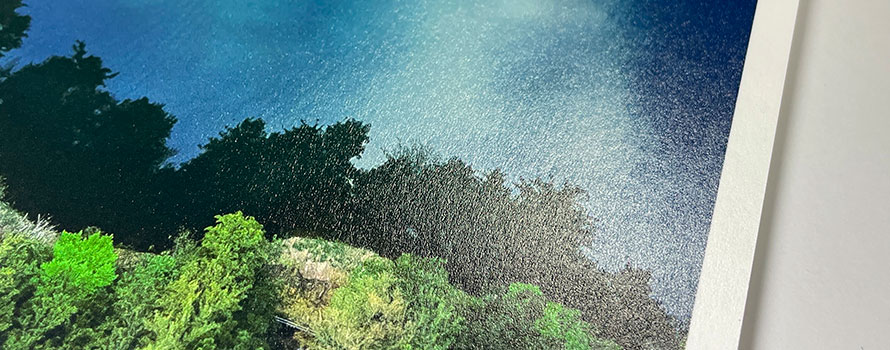What is Baryta Paper and Why Is it So Popular?

In the intricate realm of photography, the choice of paper is as vital as the camera or lens. The medium can greatly influence the final outcome of an image, adding depth, character, and a unique finish that distinguishes one photograph from another.
Among the myriad of options available, Baryta paper stands out as a classic favorite. Let's delve into what Baryta paper is and why it continues to be a popular choice among photography enthusiasts and professionals.
What is Baryta Paper?
Baryta paper was developed by Kodak around 1900. The name 'Baryta' comes from barium, a nod to the barium sulfate mixture that gives the paper its distinctive properties. This multi-layered paper usually consists of a fiber base (most often tree fiber and sometimes cotton), the barium sulfate coating, and an outer layer of light-sensitive gelatin or inkjet coating.
A baryta paper’s whiteness comes from a barium sulfate variant called blanc-fixe, which means permanent white. This material is in the coating. It is inert and lends stability to the paper's whiteness over time. The coating and base materials are free of acid, lignin, and fluorescent brightening agents. Baryta papers have the look, feel, and elegance of traditional wet chemistry print processing.
Our Best Selling Baryta Papers
Why is Baryta Paper So Popular?
Exceptional Image Quality: The fine detail and tonal range offered by Baryta paper are incomparable. The deep blacks and bright whites create a stunning contrast, making images pop.
Archival Qualities: Baryta paper boasts excellent archival properties. When stored appropriately, prints can last for over a century without noticeable fading or deterioration.
Smooth Finish: The paper offers a semi-gloss finish, which strikes a balance between matte and glossy. This ensures that images are neither too shiny nor too flat, making it perfect for a wide range of photography styles.
Feel and Weight: The tactile experience of holding a Baryta print adds to its allure. It's heavier and feels more luxurious than standard photographic paper.
Versatility: Whether it's portraiture, landscapes, monochromes, or fine art prints, Baryta paper complements all, enhancing the image's quality and aesthetic appeal.
Conclusion
The world of photography is vast, and choices are abundant. However, certain classics like Baryta paper endure because of their unmatched quality and the timeless appeal they lend to photographs. Whether you're a professional looking to impress clients or an enthusiast wanting to give your prints a museum-quality feel, Baryta paper is an investment in excellence.
More About Baryta
What is the weight and thickness of the Baryta paper?
Baryta papers are typically between 12-16 mil thick and between 270-330 gsm weight.Be sure to check the product specs for the baryta paper you are considering.
Is the Baryta paper compatible with my printer and the inks I use?
Ask the maker or reseller of your baryta paper if it compatible with your printer. The biggest barrier will be the paper’s weight and thickness. Not all printers can feed paper as thick and heavy as a typical baryta.
What is the paper's archival quality and longevity?
One of the standout features of Baryta paper is its archival quality. However, specifics can vary between brands, so it's good to ask how long prints on the paper are expected to last without noticeable fading or degradation.
Does the Baryta paper have a specific surface finish or texture?
Baryta papers might come with various finishes, from smooth to more textured, and understanding this can help one choose the right paper for the desired look and feel of the final print.
Are there any specific care or handling instructions for the Baryta paper?
As with any fine paper, avoid touching the print surface with your bare hands. Hold sheets by their edges. As the paper’s maker or seller if there are any specific recommendations or precautions one should take, such or recommendations for framing and display.
Original Publication Date: October 24, 2023
Article Last updated: October 26, 2023
Comments are closed.
Categories
About Photographers
Announcements
Back to Basics
Books and Videos
Cards and Calendars
Commentary
Contests
Displaying Images
Editing for Print
Events
Favorite Photo Locations
Featured Software
Free Stuff
Handy Hardware
How-To-Do-It
Imaging
Inks and Papers
Marketing Images
Monitors
Odds and Ends
Photo Gear and Services
Photo History
Photography
Printer Reviews
Printing
Printing Project Ideas
Red River Paper
Red River Paper Pro
RRP Newsletters
RRP Products
Scanners and Scanning
Success on Paper
Techniques
Techniques
Tips and Tricks
Webinars
Words from the Web
Workshops and Exhibits
all
Archives
June, 2024
May, 2024
April, 2024
March, 2024
February, 2024
January, 2024
December, 2023
November, 2023
October, 2023
more archive dates
archive article list




